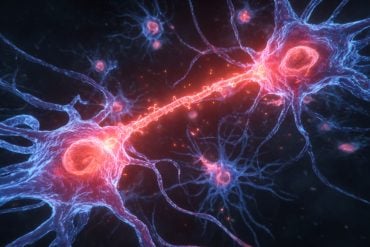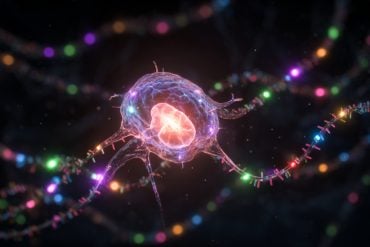Summary: Children with autism exhibit distinct eye movement patterns when viewing faces, particularly in the initial stages of visual processing. A new study found that autistic children are more likely to use an exploratory eye movement pattern, focusing on broader areas rather than immediately fixating on facial features. This behavior may be linked to reduced visual sensitivity to social cues and is associated with autism-related challenges in social communication.
Researchers aim to use these findings to develop interventions that improve face perception and social interactions for autistic individuals. The study highlights the potential of mobile eye-tracking technology to assess real-world interactions and enhance understanding of how autistic children navigate social environments. Such research provides valuable insights into the underlying mechanisms of autism and its impact on daily life.
Key Facts:
- Distinct Patterns: Autistic children are more likely to use exploratory rather than focused eye movement patterns when viewing faces.
- Initial Perception: Reduced focus on facial features early in visual processing may contribute to social communication challenges.
- Real-World Application: Researchers are exploring mobile eye-tracking technology to study how autistic children perceive faces during live interactions.
Source: University of Houston
University of Houston psychology researcher Jason Griffin, who has pioneered new ways of measuring eye movements to understand autism spectrum disorder, is reporting that children with autism focus on faces differently than other children, especially in the early stages of visual processing.
His findings may lead to improvement in face processing for those with the neurodevelopmental condition.

For most people, looking eye-to-eye with someone while talking seems an important yet innocuous social convention – one barely thought of during polite conversation. But for those with autism, characterized by differences in social communication, including reduced facial recognition, the struggle is real.
“In this study, our primary goal was to test the hypothesis that children with autism display qualitatively distinct eye movement patterns during social perception,” reports Griffin in Biological Psychiatry.
Griffin utilized new analytic techniques to assess and compare the looking behavior in a large group of autistic and neurotypical children as they viewed social images.
They found that children with autism prioritize faces in different ways, particularly when they first see them.
“Our analysis supported the existence of two eye movement patterns that emerged across three social perception assays,” said Griffin.
“A focused pattern was characterized by small face regions of interest that captured looking immediately. In contrast, an exploratory pattern was characterized by larger face regions of interest that included nonsocial objects and did not capture looking immediately”
Researchers found that autistic children were more likely to use this explorative method compared to the focused eye movement pattern. Decreased likelihood of precisely looking at faces early in visual processing may be an important feature of autism that is associated with autism-related symptomology and may reflect less visual sensitivity to face information.
Griffin’s inspiration
This is not Griffin’s first foray into the world of autism research. He’s been at it for many years, spending five of those years working on a team to develop a computer-based intervention game for autistic adolescents to play. It’s designed to change their eye movements to improve their perception of where another person is looking.
Griffin’s inspiration for all his pioneering research came from home, spurred on by growing up with an autistic brother.
“My brother and I have always been best friends. We grew up together, rode bikes together and played video games together,” said Griffin in a recent article published in Science.
“As children, he did not speak or make eye contact much and struggled to interact socially. I do not remember exactly when I knew my brother had autism, but I knew we would be best friends forever because he was my younger brother.”
Griffin’s commitment and contributions to autism research made him a finalist for the prestigious NOMIS & Science Young Explorer Award, which recognizes young scholars who are exceptionally bold and innovative in their approach to scientific inquiry. He will be recognized for this award at University of Zurich in Switzerland.
The real world
In the Griffin lab, with real life as his mentor, Griffin is progressing a line of science he calls naturalistic neuroscience – basically taking things out of the lab into the real world.
“We have kids come in, they look at a computer screen that has pictures of faces or social scenes, and we assess how long they look at the face or the eyes,” said Griffin. “This is great science. don’t get me wrong, but there is an opportunity to explore how some of these processes play out in real world situations.”
With recent funding from the Autism Science Foundation, Griffin is exploring how we can use mobile eye-tracking technology to understand how autistic children look at faces in real world situations, like during a face-to-face conversation.
“There’s so much that’s different about being in front of another human. And ultimately, that’s where autistic people and everyone else lives—in the real world,” said Griffin.
About this autism research news
Author: Laurie Fickman
Source: University of Houston
Contact: Laurie Fickman – University of Houston
Image: The image is credited to Neuroscience News
Original Research: Open access.
“Spatiotemporal Eye Movement Dynamics Reveal Altered Face Prioritization in Early Visual Processing Among Children With Autism” by Jason Griffin et al. Biological Psychiatry
Abstract
Spatiotemporal Eye Movement Dynamics Reveal Altered Face Prioritization in Early Visual Processing Among Children With Autism
Background
Reduced social attention—looking at faces—is one of the most common manifestations of social difficulty in autism that is central to social development. Although reduced social attention is well characterized in autism, qualitative differences in how social attention unfolds across time remains unknown.
Methods
We used a computational modeling (i.e., hidden Markov modeling) approach to assess and compare the spatiotemporal dynamics of social attention in a large, well-characterized sample of children with autism (n = 280) and neurotypical children (n = 119) (ages 6–11) who completed 3 social eye-tracking assays at 3 longitudinal time points (baseline, 6 weeks, 24 weeks).
Results
Our analysis supported the existence of 2 common eye movement patterns that emerged across 3 eye-tracking assays. A focused pattern was characterized by small face regions of interest, which had high a probability of capturing fixations early in visual processing. In contrast, an exploratory pattern was characterized by larger face regions of interest, with a lower initial probability of fixation and more nonsocial regions of interest.
In the context of social perception, children with autism showed significantly more exploratory eye movement patterns than neurotypical children across all social perception assays and all 3 longitudinal time points. Eye movement patterns were associated with clinical features of autism, including adaptive function, face recognition, and autism symptom severity.
Conclusions
Decreased likelihood of precisely looking at faces early in social visual processing may be an important feature of autism that is associated with autism-related symptomology and may reflect less visual sensitivity to face information.







